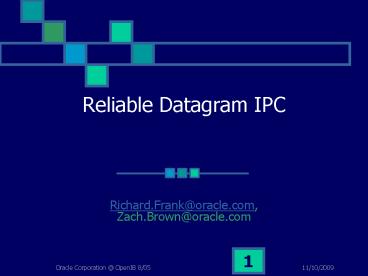Reliable Datagram IPC - PowerPoint PPT Presentation
1 / 24
Title:
Reliable Datagram IPC
Description:
Key for target buffer returned from RDS interface (get memory handle) ... Remote side initiates directed send passing in key of remote target buffer ... – PowerPoint PPT presentation
Number of Views:49
Avg rating:3.0/5.0
Title: Reliable Datagram IPC
1
Reliable Datagram IPC
- Richard.Frank_at_oracle.com, Zach.Brown_at_oracle.com
2
Vision Statement
- A low overhead, low latency, high bandwidth,
ultra reliable, supportable, IPC protocol and
transport system - Which matches Oracles existing IPC models for RAC
communication - Optimized for Xfers from 200 bytes to 8meg
3
Goal and Objective
- Support for a reliable datagram IPC in OpenIB
- Based on Socket API
- Minimal code change / testing for Oracle
- Failover inter HCA and intra HCA ports
- Runs over IB, Ether, iWARP, etc
- 2 month validation / certification for RAC
4
Todays Situation
- TCP streams used for connections to database by
external clients, app servers, etc. - Reliable Data grams used for internal database
IPC (RAC) - Thousands of processes
- 200k associations (not connections)
- 64 nodes
5
Parallel Query
- SQL decomposed into execution plan / tree
- Set of producer / consumer pipelined stages
- Based on data accessed (rows,physical
organization,logical operations (hash,index) - Each execution stage has producer / consumer
slave groups (source,sync) - Each group can be many slaves 32
6
Parallel Query
- Operation tree / plan is not aware of slave
locality comm. could be local via shared memory
or remote via IPC. - N N, 1 N, N 1 comm. between groups (16
source, 16 sync, 16 nodes 65k associations
for nn com) 1 query - May change group organization / comm model at
each stage of plan. - 64k msg size capable typical today 16k
7
Oracle Buffer Cache
- Distributed Cache
- Client / Server
- Client sends request for buffer
- Server Sends back buffer (DDP)
- Each node has pool of servers
- Any client can ask any server
8
Oracle Buffer Cache
- Buffer size is 8k by default but can be 2k, up to
32k in size - Associations per server are n-1 C
- C clients per node, n Nodes
- 16-1800 12k per server process.
- 8 servers per node 96k associations
9
Oracle IPC Usage
- New database functionality will significantly
increase IPC utilization - Approaches database I/O rates
- Very large msgs -gt 8meg
10
Reliable Datagram IPC
- UDP Oracle adds reliable delivery via user mode
wire protocol engine. - Two sockets per process, thousands of msgs on
wire - Slow sends times (windowing,acks,retrans)
- Holds together but degenerates under CPU load
- Well tested !
11
Available Options
- uDAPL / itAPI not supporting
- IPOIB high CPU overhead, same unreliable
delivery (UDP) - SDP connection oriented
- We want to take our existing well tested UDP
module, shutoff most of it to run over an O/S
provided RD IPC
12
Recommendation
- RD Reliable Datagram IPC over IB
- 50 less CPU than IPOIB, UDP
- ½ Latency of UDP (no user-mode acks)
- Within 5 of uDAPL thru-put using Oracle
- Minimal code change reduced our UDP module by
70 - removed windowing, acks, retransmissions,
etc. - RDS driver 1k C lines (b-copy)
- Decoupled from user-mode CPU loading
- Passes all Oracle regression tests in lt 2 wks
!!!! - Supports fail-over across and within HCAs.
13
RDS IPC over IB
- Uses IB reliable connection (RC)
- Node to Node level connection
- User mode sockets share small pool of node to
node RCs. - Formed either dynamically at send or at system
startup
14
Oracle Block Service Rate
15
Service Response Time
16
Cpu Cost Per Block Served
17
(No Transcript)
18
RDS IPC
- Implemented in 3 phases
- b-copy
- Zero Copy
- Z-copy Directed Sends / Recvs (ES-API additions)
19
B-Copy
- Sends are copied and completed immediately
- Sends are not guaranteed to have made it to
remote application. - If Send fails async to submission application
must detect loss of send - Can only fail if no path to destination (remote
port / process is gone or path has failed no
alternate path
20
B-Copy Send/Recv
- Recvs are buffered in kernel / queued to remote
socket. - If total buffers queued to remote socket exceeds
threshold then sending socket is back pressured
(ewouldblock) when sending to blocked remote
socket.
21
Z-Copy Send/Recv
- Dynamic registration of buffer gt size
- Application is not required to do explicit
registration. - Oracle IPC buffers are in shared memory and
private heap - impractical to pre-register
- O/S must manage any caching of registrations
22
Directed Sends / Recvs(DDP)
- Key for target buffer returned from RDS interface
(get memory handle) - Key is sent by application to remote side
- Remote side initiates directed send passing in
key of remote target buffer - Uses RDMA write to move data
- ES-API additions working on definition
23
Next Steps ?
- RDS bcopy supported in Oracle 10.2.0.2.
- RDS from SilverStorm ported to OpenIB Gen2
- Preparing to test OpenIB RDS at Oracle
24
Next Steps
- Work on zcopy / directed send (ddp) specification
now (ES-API). - RD IPC Docs from Oracle
- Richard.Frank_at_oracle.com
- RDS/eth
- Zach.Brown_at_oracle.com































